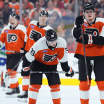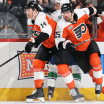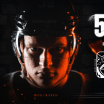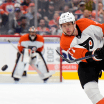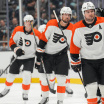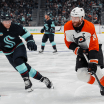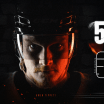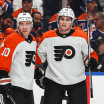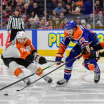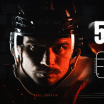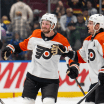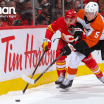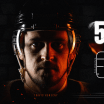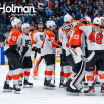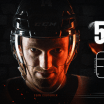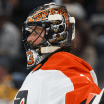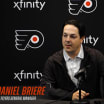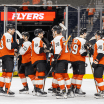Heading into the 2020-21 season, the Flyers had high hopes that several young players who showed progress at the NHL level the previous year would continue to take positive steps in their careers. Unfortunately, some of these players regressed.
Offseason Inventory: Comeback Trail Players
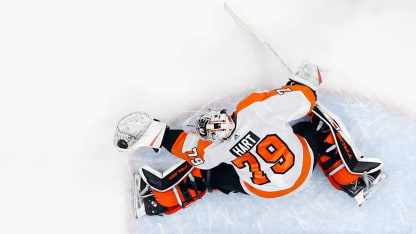
Meanwhile, it was expected that the long-term health-related absences of Oskar Lindblom and Nolan Patrick in 2019-20 would require patience upon their returns. The aim was they would eventually settle in and play effectively. The good news: Patrick stayed reasonably healthy throughout the season, and Masterton Trophy winner Lindblom remains cancer-free a calendar year after completing chemotherapy and rib-removal surgery to treat Ewing's Sarcoma.
Entering the 2021 offseason, there are only so many cap dollars to go around (even if the club can open up additional cap space) for the Flyers to fill roster needs for the 2021-22 campaign. The Flyers will need many of these players to have bounceback campaigns on the ice in 2021-22. Here's a look at five Flyers' players on the comeback trail, performance wise.
CARTER HART
Age: 22
Contract Status: Restricted free agent
Prior to this past season, Hart never experienced any significant adversity in either his junior or pro careers: three-time Del Wilson Trophy (WHL Goalie of the Year) winner, two-time CHL Goalie of the Year winner, IIHF World Junior Championship gold medal winner as Team Canada's starter in 2017-18, graduated after 18 games from the American Hockey League to the NHL at age 20, broke Bernie Parent's single-season home save percentage franchise record in 2019-20, and backstopped the Flyers to within one win of reaching the Eastern Conference Final in the playoffs.
Unfortunately and unexpectedly, Hart had a very poor third pro season/ second full NHL season in 2020-21. His 9-11-5 record, .877 save percentage and 3.67 goals against average along with being pulled early in four of his 25 starts and suffering a minor late-season injury fell far short of what was expected heading into the season.
In fairness, the team often played poorly in front of him and the sparsity of practice time seemed to affect the goalie (who is very much a creature of routine and habit) more than any other player on the team. However, the bottom line is that Hart did not hold up his end of the bargain this past season and a full return to form in 2021-22, regardless of his goaltending partner next season, is absolutely vital to the Flyers playing at much closer to their 2019-20 level than how they played this past season.
Digging beneath the surface of Hart's 2020-21 season, the campaign can roughly be broken down this way: In January and February, Hart's performance was inconsistent. Hart only had a few performances where he was at the top of his game without allowing any realistically stoppable goals, but subpar team defense was a bigger problem. In March, Hart shockingly struggled mightily with both mechanics (especially his glove side but also in terms of committing too early, and staying on-angle) and self-confidence. In April, he started to trend back in a more positive direction but then got injured and was preemptively shut down for the rest of the season.
At the time of the Flyers' 7-3 loss to the Bruins in Lake Tahoe on Feb. 21 -- a game in which Hart was pulled in the second period -- he had allowed 20 goals against the Bruins in going 0-2-2 (5.31 GAA, .843 SV%). However, against the rest of the East Division to that point, he'd allowed a combined 18 goals in seven games (5-1-1, 2.73 GAA, .919 SV%). That was soon followed by Hart recording a 28-save shutout on the road in Buffalo in his final start of February.
Let's break down Hart's four pre-March games against Boston a little further to gain additional context:
* Jan 21 @ BOS: The Flyers were massively outplayed in the first period and controlled the middle frame. Philly took a 2-0 lead into the third period largely on the strength of Hart stopping all 18 shots he faced (including 14 in the first period). Unfortunately, the Flyers were unable to hold off a Bruins' surge in the third period and ultimately lost, 5-4, via shootout. Hart allowed a stoppable turnaround shot through the five-hold by Charlie Coyle on the second Boston goal. The other three Boston tallies were primarily the fault of the skaters in front of Hart or the credit of Boston attackers.
* Jan. 23 @ BOS: Hart kept the Flyers in the game early, stopping nine of 10 shots in the first period as Philly took a 1-0 deficit to intermission despite being significantly outplayed. The final 40 minutes were rough, both for Hart and the team, especially a three-goal Bruins outburst in the third period that turned a 3-1 game into a 6-1 blowout. Two of the goals that Hart allowed were on shots he'd typically save and another, while not an easy opportunity, was also not unstoppable. At the end of the game, the normally even-keeled Hart shattered his stick over the crossbar in frustration.
* Feb. 2 vs BOS: Hart (31 saves) played fine in this 4-3 overtime loss to the Bruins. Bad penalties by the Flyers, three unstoppable point-blank goals by the deadly David Pastrnak and a 4-on-3 overtime power play marker for Boston were the Flyers' problems in this game as they were unable to nail down a win after leading 3-1 midway through the third period.
* Feb 21 @ BOS (Lake Tahoe): None of the goalies in this game fared well, but Hart in particular struggled. He was pulled after two periods, allowing six goals on 23 shots. Boston won, 7-3.
Hart's shutout win in Buffalo raised hopes of the player quickly recovering his game. Unfortunately, the month of March was disastrous both for Hart and the entire team regardless of the opponent. Hart started 10 games, was pulled twice and posted a 2-6-0 record, 5.04 GAA and .815 save percentage. Brian Elliott fared only marginally better (4-4-1, 3.74 GAA, ..847 SV%).
The month of March saw the Flyers, after an 11-4-3 start to the season, tumble in the standings and fall out of the playoff race. The club never recovered. At least Hart, after getting in some much needed extended practice time, started to look a little more like himself despite a 1-2-2 record (2.31 GAA, .910 save percentage).
In his final start before missing the rest of the season, Hart took first-star honors in the Flyers' 2-1 road shootout victory in Pittsburgh. The Penguins generated five odd-man rushes in regulation and two more in overtime as well as multiple medium to high-danger chances during the second period and beyond. Hart wound up with 30 saves on 31 shots. Hart then went 2-for-3 in the shootout.
This offseason, if the Flyers do not re-sign unrestricted free agent Elliott, they may look for a netminder who could push Hart for playing time next season if Hart (who will turn 23 on Aug. 13) struggles for consistency. Hart is a restricted free agent this summer for the first time in his career. He does not have arbitration rights. Hart's difficulties this past season make it more likely that he will receive a bridge contract from the Flyers rather than the long-term, top-dollar extension that seemed probable after his 2019-20 season.
OSKAR LINDBLOM
Age: 24
Contract Status: Signed through 2022-23 ($3 million AAV)
A runner-up last season for the Masterton Trophy, which goes to a player who exemplifies "perseverance, sportsmanship, and dedication" to the sport of hockey, Flyers left winger Oskar Lindblom has won the award for the 2020-21 season. In December 2019, Lindblom was diagnosed with Ewing Sarcoma, a rare form of bone cancer more frequently found in pediatric patients than in adults.
At the time of his diagnosis, Lindblom was leading the Flyers in goal-scoring. The previous year, after interim head coach Scott Gordon promoted Lindblom at mid-season from a fourth-line role to the middle six of the lineup, Lindblom scored 13 goals over the season's final 37 games to tie Travis Konecny for third on the team.
Over the next half-year following his cancer diagnosis, Lindblom underwent a rigorous course of chemotherapy. He also underwent rib removal surgery to ensure that no detectable cancer remained. On July 2, 2020, Lindblom ceremonially rang the bell at the Abramson Center at Pennsylvania Hospital, signifying the end of his treatments.
Although he had lost a lot of weight and muscle mass, Lindblom almost miraculously made it back into the Flyers' lineup for two games in their seven-game Eastern Conference Semifinal series loss to the New York Islanders. His return to the ice came after the voting period ended for the 2019-20 Masterton Trophy but he nonetheless was selected as one of the three finalists among the 31 nominees (one per team) voted on by the Professional Hockey Writers Association (PHWA).
During the 2020 offseason (autumn through December), Lindblom regained some muscle mass but he was still playing catch-up in the physical strength and conditioning departments. One of the NHL's most underrated forecheckers and an effective two-way player -- in addition to showing an ability to score in close to the net -- prior to the Ewing Sarcoma diagnosis, Lindblom was not nearly as consistently effective during the 2020-21 season as he'd been before his cancer battle. His energy levels noticeably fluctuated over the course of the compacted schedule. Nonetheless, he scored eight goals, all at even strength.
Lindblom's inconsistency on the ice over the course of his return season, which also included a bout with COVID-19 (fortunately, his symptoms were mild), a very abbreviated training camp and the absence of any preseason tuneup games, was predictable in hindsight. He should be closer to his accustomed form in 2021-22. Far more important than anything related to his play on the ice, all of Lindblom's followup cancer scans have come up clean. He remains medically cancer-free.
NOLAN PATRICK
Age: 22 (turns 23 on Sept.19)
Contract Status: Restricted free agent
Patrick is an arbitration-ineligible restricted free agent for the second straight offseason. It's a positive that he mostly stayed healthy in 2020-21 but it was a frustrating and ineffective season overall for the second overall pick of the 2017 NHL Entry Draft.
After missing the entire 2019-20 season due to chronic migraine syndrome and then posting a mere nine points (4g, 5a) in 2020-21, Patrick does not have much contract negotiation leverage and his current trade value is uncertain.
Patrick's rookie season of 2017-18 was promising: 13 goals, 30 points in 73 games at age 19 isn't too bad. He had a second-half stretch where he posted 10 points (5g, 5a) in 12 games including a four-game goal scoring streak. There were also stretches where Patrick was a non-factor; a little too much perimeter play, not using his size effectively. On the whole, though, the second overall pick of the 2017 Draft got off to a promising enough start to believe that he was on track to gain more consistency with more experience.
Year two for Patrick, 2018-19, was a mixed bag. He made subtle improvements on both sides of the puck, but his offensive development was essentially stagnant (13 goals, 31 points in 72 games).
Streakiness remained: nine points (5g, 4a) in 10 games at one early season juncture, four goals and six points in three games at another but also a 24-game goal drought with a mere two assists in between. Later, he had 10 points in 13 games (2g, 8a) but finished the season with one point (0g, 1a) over his final nine games; overlapping a concussion and then sitting out the final two games of the season.
After missing the 2019-20 season, Patrick started out the 2020-21 campaign with five points in the first seven games (2g, 3a) and then posted four points in 45 games (2g, 2a) the rest of the way. Lacking confidence and assertiveness, he often played a perimeter game until the latter stages of the season when he'd made some subtly good plays and venture inside and below the dots with a little more frequency but without much reward on the scoresheet.
Patrick received significant power play time until late in the season -- 2:11 per game from the start of the season through the end of March, 0:55 in April and May -- but produced only two power play goals (one of which came in the first period of the season opener) and a single power play assist for the entire campaign. Also, despite the well-known flaws of the traditional plus-minus stat, it is a bit alarming that Patrick's minus-30 was tied for the second-worst among all NHL players and was the only non-Buffalo player in the leaguewide bottom four. This spoke to losing a majority of battles on both sides of the puck.
Patrick faces a significant climb next season just to get back to where he was in years one and two in the NHL.
PHILIPPE MYERS
Age: 24
Contract Status: Signed through 2022-23 ($2.25 million AAV)
Myers qualified as an NHL rookie in 2019-20 and had a promising season. Paired frequently with Travis Sanheim (who had also been a regular partner in the AHL with the Lehigh Valley Phantoms), they thrived both individually and in tandem as the season progressed. The pairing had a rather uneven postseason performance in the Bubble in Toronto but hopes were high for a true breakout season in 2020-21.
With the Flyers losing Matt Niskanen to early retirement during the offseason, there was speculation that Myers could even earn a top-pairing spot as the right-side defense partner for Ivan Provorov. Unfortunately, Myers never got untracked, dealing with an early-season injury, wild swings of inconsistency within games, decision-making issues (sometimes being too aggressive, other times too reactive) and struggles in correcting mistakes. Myers was a healthy scratch multiple times, and wound up dressing in just 44 of 56 games.
It wasn't all negative all the time. There were games or stretches of games where Myers was highly effective in using his combination of size, strength and mobility. However, he never got on a roll for any extended period of time and it seemed that many times where he -- or Sanheim -- made a mistake, the puck ended up in the Flyers' net.
Amid the team-wide problems in March, Myers had an exceptionally tough month as he was on the ice for 24 opposition goals (Sanheim was on for a team-high 25) while being on the ice for just seven Philadelphia goals. Myers had his worst month in terms of turnovers (10 charged giveaways in 15 games) and in terms of getting his own shot attempts on the net. His puck-possession analytics were fine (54.55 percent even-strength Corsi, 51.6 percent expected goals share) but the overall picture wasn't pretty.
Myers play, largely in the third-pairing role, showed signs of picking up when he was in the lineup over the latter part of the season (he dressed in 17 of 21 games). It was not enough to rescue his overall season but it was at least a positive closing note on a tough season.
NICOLAS AUBE-KUBEL
Age: 25
Contract Status: Signed through 2021-22 ($1.075 million AAV)
Aube-Kubel became a regular starter in the Flyers' lineup as the 2019-20 progressed. He averaged 11:17 of ice time in 36 games, including periodic second power play unit ice time. At even strength, he was a tenacious forechecker and showed hints of offensive upside. The player parlayed his promising season into a two-year contract extension and a raise in salary.
Unfortunately, Aube-Kubel took a significant backward step in 2020-21. He was prone to taking an excessive number of unnecessary minor penalties. His forechecking work was not as consistently effective as it was the previous year. Defensively, there were times where Aube-Kubel made the incorrect coverage read or went to the wrong spot. Offensively, he regressed from seven goals and 15 points in 36 games to three goals and 12 points in 50 games.
Aube-Kubel needs to use his north-south skating ability and willigness to take the body to more consistent advantage, along with staying out of the penalty box. He may face competition for a roster spot for the 2021-22 season

